|
An Acquired Taste
by
Bob Brooke
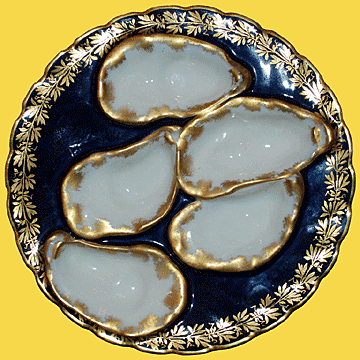 The
Victorians were mad for oysters, and any table with pretensions of
elegance had to serve oysters, on or off the half' shell. The hearty consumption of oysters by Americans
during the 19th century led to the production of one of the most
beautiful Victorian dinnerware items—the oyster plate. The
Victorians were mad for oysters, and any table with pretensions of
elegance had to serve oysters, on or off the half' shell. The hearty consumption of oysters by Americans
during the 19th century led to the production of one of the most
beautiful Victorian dinnerware items—the oyster plate.
The Oyster in History
For thousands of years, oysters have graced the tables of Roman
emperors, French kings and American statesmen. Ancient Romans and Greeks
were noted for their consumption and caring cultivation of oysters.
Oysters fascinated the Greeks, and Aristotle notes that the Greeks began
to cultivate them as early as the 4th century, B.C.E.
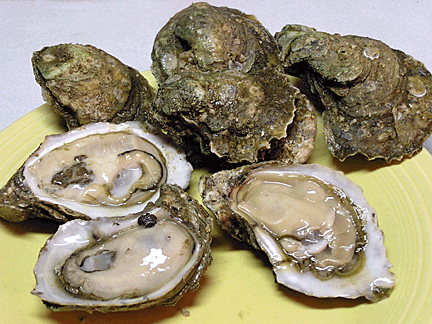 More
than 4,000 years ago the coastal Indians of North America ate oysters in
great quantities. Large oyster shell mounds are reminders of their culinary tastes. Unlike the Romans and
Greeks who preferred them
raw on the half shell, Indians ate them cooked and probably created the
first oyster stew. More
than 4,000 years ago the coastal Indians of North America ate oysters in
great quantities. Large oyster shell mounds are reminders of their culinary tastes. Unlike the Romans and
Greeks who preferred them
raw on the half shell, Indians ate them cooked and probably created the
first oyster stew.
There are many legends associated with the oyster. Aphrodite, the
goddess of love, is said to have arisen from the sea on an oyster shell, endowed with the power to grant beauty and charm to others.
In Wales, people believed that the complexions of pale young women would
improve if they ate oysters. The Chinese thought oysters would erase
freckles. Casanova credited the oyster with enhancing his legendary
prowess in the bedroom.
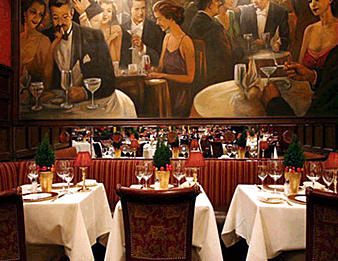 There
are many tales of excesses in eating oysters, probably because of their
reputation for increasing sexual passion. Historians believe Roman
Emperor Vitellvis ate 1,000 oysters at a single sitting. King Henry IV
ate 400 before dinner. In Ireland a man named Dando ate half his weight—over 200 pounds—in oysters. He lived to a ripe old age, and when he
died, oyster shells surrounded his grave. Witnesses reported that
Diamond Jim Brady would eat over 100 raw oysters at Delmonicos
Restaurant in New York City before his dinner. There
are many tales of excesses in eating oysters, probably because of their
reputation for increasing sexual passion. Historians believe Roman
Emperor Vitellvis ate 1,000 oysters at a single sitting. King Henry IV
ate 400 before dinner. In Ireland a man named Dando ate half his weight—over 200 pounds—in oysters. He lived to a ripe old age, and when he
died, oyster shells surrounded his grave. Witnesses reported that
Diamond Jim Brady would eat over 100 raw oysters at Delmonicos
Restaurant in New York City before his dinner.
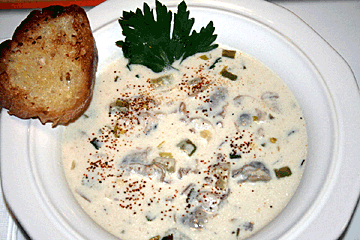 The
United States was in the throes of an oyster cult in the 19th century,
and Americans had an "oyster mania." Oysters were eaten raw, baked,
fried, fricasseed, in soup, in pies, in stuffing and garnished on top of
grilled steak. In Home Cooking (Boston, 1853) Mrs. J. Chadwick suggested
adding 100 oysters to her modest gumbo. The
United States was in the throes of an oyster cult in the 19th century,
and Americans had an "oyster mania." Oysters were eaten raw, baked,
fried, fricasseed, in soup, in pies, in stuffing and garnished on top of
grilled steak. In Home Cooking (Boston, 1853) Mrs. J. Chadwick suggested
adding 100 oysters to her modest gumbo.
Every coastal city had its specialized oyster houses, and peddlers
hawked oysters in the street. Signs reading, “All the oysters you can
eat for 6 cents,” appeared on oyster houses in Boston, New York,
Philadelphia and Baltimore.
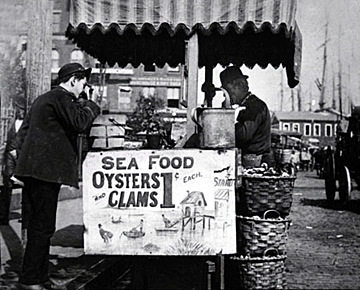 In
1859 residents of New York spent more money on oysters than on red meat.
Many oysters sold in New York City came from two-story oyster barges
anchored in the East River along East Street. Sailing vessels brought
fresh oysters to the waterside and unloaded them onto the decks of the
barges where men sorted and loaded them onto wagons and carts for
delivery throughout the city. New York's Fulton Fish market sold about
50,000 oysters daily in 1877. Downings, the New York oyster cellar at 5
Broad St., was a popular establishment where people discussed politics, art and
philosophy. In his book The Oyster House Cookbook, Fred
Parks notes, "No evening of pleasure was complete without oysters; no
host worthy of the name failed to serve `the luscious bivalves,' as they
were actually called, to his guests. In every town there were oyster
parlors, oyster cellars, oyster saloons, and oyster houses, stalls and
lunchrooms." In
1859 residents of New York spent more money on oysters than on red meat.
Many oysters sold in New York City came from two-story oyster barges
anchored in the East River along East Street. Sailing vessels brought
fresh oysters to the waterside and unloaded them onto the decks of the
barges where men sorted and loaded them onto wagons and carts for
delivery throughout the city. New York's Fulton Fish market sold about
50,000 oysters daily in 1877. Downings, the New York oyster cellar at 5
Broad St., was a popular establishment where people discussed politics, art and
philosophy. In his book The Oyster House Cookbook, Fred
Parks notes, "No evening of pleasure was complete without oysters; no
host worthy of the name failed to serve `the luscious bivalves,' as they
were actually called, to his guests. In every town there were oyster
parlors, oyster cellars, oyster saloons, and oyster houses, stalls and
lunchrooms."
 But
by the end of the "oyster century" America was running out of oysters.
Even fishermen on the Chesapeake Bay couldn't keep up with the local demand. There were
too many people and too few oysters. Today, from Cape Cod to the Gulf of
Mexico, the once plentiful oyster is dying out. Each year overharvesting,
red tides and diseases have taken a toll. Fortunately, in the past 10
years oyster farming has become a science, and oyster farmers carefully
cultivate them through each step of development. But
by the end of the "oyster century" America was running out of oysters.
Even fishermen on the Chesapeake Bay couldn't keep up with the local demand. There were
too many people and too few oysters. Today, from Cape Cod to the Gulf of
Mexico, the once plentiful oyster is dying out. Each year overharvesting,
red tides and diseases have taken a toll. Fortunately, in the past 10
years oyster farming has become a science, and oyster farmers carefully
cultivate them through each step of development.
While oysters enjoy a modest increase in popularity today, that's nothing
compared to their popularity during their heyday. True oyster aficionados still frequent oyster
bars, scattered around the world, for fresh oysters served very cold on
the half shell over ice. They pick up the oyster and tip the shell to
their lips, taking both the liquor and oyster into their mouth, saying,
"This is the only way to really enjoy oysters!"
The Oyster Plate
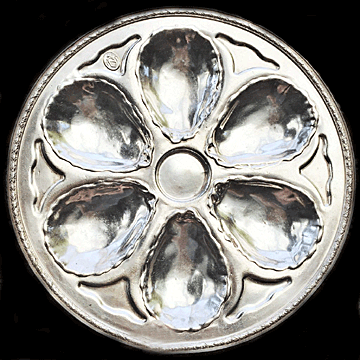 The
popular craze of eating oysters made beautifully crafted oyster plates a
necessity in restaurants and fashionable homes. Sumptuous meals were the
order of the day for the wealthy during the 19" century and early 20th
century in Europe and America. Servants served four or five separate courses, and special events could easily warrant 10 or more. It
became fashionable for the servants to clear the dining table after each
course, removing all the dishes and silverware and replacing them with a
different set. This custom gave affluent families an excuse to show off
their lovely china and silver. The
popular craze of eating oysters made beautifully crafted oyster plates a
necessity in restaurants and fashionable homes. Sumptuous meals were the
order of the day for the wealthy during the 19" century and early 20th
century in Europe and America. Servants served four or five separate courses, and special events could easily warrant 10 or more. It
became fashionable for the servants to clear the dining table after each
course, removing all the dishes and silverware and replacing them with a
different set. This custom gave affluent families an excuse to show off
their lovely china and silver.
As Victorians saw oyster related items of china and silver in grand
hotels, dining cars and steamships, they had to have them in their own
homes. To supply oyster plates to a growing market, ceramic companies in
the United States and Europe created an endless variety of them, some of rare
beauty and delicacy.
Types of Oyster Plates
There were three types of oyster plates, all of which people used from
1860 to 1910. People used the first, a bowl-like dish, to serve oysters
on the half shell on a bed of ice. An underplate to catch the melting
ice accompanied this. The second type had individual wells to hold
oysters on the half shell, but without ice. The third, and most
collectible, style is a flat plate with wells that are often oyster
shell-shaped, to hold the oysters without both shell and ice, providing
a neater presentation, because there’s no melting ice, and there are no
oyster shells to scratch the plate. This type of plate is often very
ornate and comes in many designs.

Oyster plates come in porcelain or majolica pottery and vary in shape, in colors, and in the number of receptacles
or wells. Makers also created ones of glass, silver, and pewter. Many have a deep center well which was used for a lemon wedge,
sauce, other condiment, or if large enough, for crackers. The wells
range from one to six—two wells being rare. Potteries produced larger plates as well, holding from one to three dozen oysters.
Minton made a magnificent three-tiered lazy Susan holding 27 oysters, designed for use at large
parties or banquets.
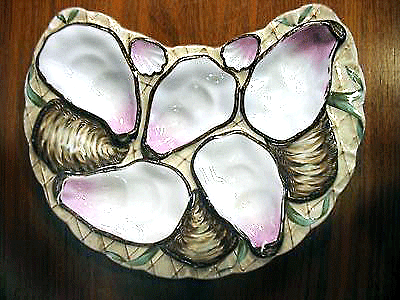 China
makers produced oyster
plates in a variety of interesting shapes. They can be found
round, square, triangular, fan and crescent-shaped and in animal forms,
such as scallops, oysters and fish. They decorated them with lavish
gold highlights, scrollwork and pearl-like lusters. Some plates feature underwater foliage, shells, flowers and other sea
motifs. China
makers produced oyster
plates in a variety of interesting shapes. They can be found
round, square, triangular, fan and crescent-shaped and in animal forms,
such as scallops, oysters and fish. They decorated them with lavish
gold highlights, scrollwork and pearl-like lusters. Some plates feature underwater foliage, shells, flowers and other sea
motifs.
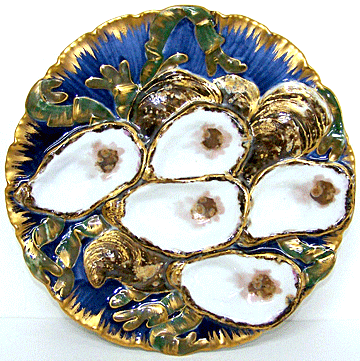 So
popular were the oyster plates that in 1879 President Rutherford B.
Hayes ordered a service of them from Haviland & Company for a state dinner
party he was planning. The "Presidential" oyster plates have five wells,
surrounded by southern raccoon oysters, which have the outside of their
shells showing. The arrangement vaguely resembles the outline of a
turkey. This design was a creation of artist Theodore R. Davis, whose
signature is on the underside of each plate. So
popular were the oyster plates that in 1879 President Rutherford B.
Hayes ordered a service of them from Haviland & Company for a state dinner
party he was planning. The "Presidential" oyster plates have five wells,
surrounded by southern raccoon oysters, which have the outside of their
shells showing. The arrangement vaguely resembles the outline of a
turkey. This design was a creation of artist Theodore R. Davis, whose
signature is on the underside of each plate.
Oyster Plates as Part of Dinnerware Sets
Having observed the Victorian passion for oysters, virtually every maker
of dinnerware began producing oyster plates, soon
incorporating them into the massive sets of dinnerware sets of the day.
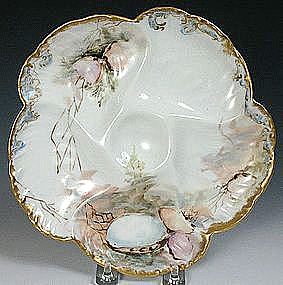 The
town of Limoges was the center of hard-paste porcelain production in
France, and many companies exported lovely oyster plates, along with
their dinnerware service to America. One of the most famous, Haviland &
Company, designed as many as 60,000 chinaware patterns. The company
decorated many of its oyster plates with delicate floral designs in
pastel colors so that they would blend more easily with existing china
services. The
town of Limoges was the center of hard-paste porcelain production in
France, and many companies exported lovely oyster plates, along with
their dinnerware service to America. One of the most famous, Haviland &
Company, designed as many as 60,000 chinaware patterns. The company
decorated many of its oyster plates with delicate floral designs in
pastel colors so that they would blend more easily with existing china
services.
Not to be outdone by the French, over 250 German porcelain factories
also produced oyster plates during the late 19th and early 20th
centuries. Tody, these plates can be identified with the mark consisting
of a crown over a shield
with the word "Weimar" diagonally crossing the
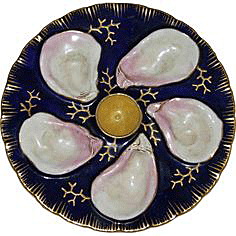 shield. shield.
In
the United States, the Union Porcelain Works of Greenport, N.Y., was the
first American company to make oyster plates. It was established by
German potters about 1854 and purchased later by C.H.L. Smith and Thomas
C. Smith. They registered a logo consisting of an eagle's head with the
letter "S" in its beak in 1877. This logo along with the letters U.P.W.
appears on most of their oyster plates. This company made two sizes of clam-shaped plates
and one round plate. All are rare and expensive today.
Majolica Oyster Plates
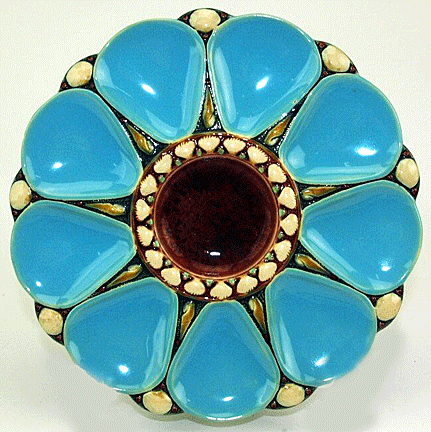 Collectors
actively seek majolica
oyster plates because of their vibrancy
of color and dramatic designs. Companies used high-fire lead glazes on
earthenware to produce many elaborate and colorful finishes to the
plates. In America, majolica became popular because it was inexpensive
and available in many different pieces. Collectors
actively seek majolica
oyster plates because of their vibrancy
of color and dramatic designs. Companies used high-fire lead glazes on
earthenware to produce many elaborate and colorful finishes to the
plates. In America, majolica became popular because it was inexpensive
and available in many different pieces.
Majolica oyster plates produced in England are some of the most
beautiful and expensive. Thomas Minton established a famous pottery in
Stoke-on-Trent in 1793. He hired Leon Arnoux, who developed colored
majolica pieces for him, as his art director in 1849. Popular motifs
included leaves, shells, seaweed and fish. Wedgwood
also made many unusual majolica plates with a great amount of detail.
The Market for Oyster Plates
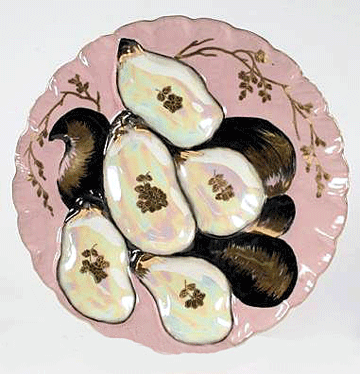 Generally,
collectors favor oyster plates made between 1860
and 1910 because of their endless variety available at every price level. Generally,
collectors favor oyster plates made between 1860
and 1910 because of their endless variety available at every price level.
Examples from well-known makers and artist-signed pieces bring
higher values. Turkey oyster plates are the most popular with collectors. These
plates made by Haviland before 1892 are very special if they're
perfect. And majolica oyster plates are an example of the high end of
the price scale.
As with any antiques and collectibles, you should buy the best
available within your budget. Some antiques experts suggest having a
plan or collecting on a theme. It's possible to amass a beautiful, diverse, historically significant
collection of oyster plates—and you don't even have to like oysters to
enjoy them.
Prices range from a low of about $15 for a 9-inch plate to $300 for a
Minton plate, with six white wells and moriage decoration, dating from
about 1900. Large, ornate serving plates can sell for as much as $2,000.
<
Back to Antiques Archives
Next Article > |
